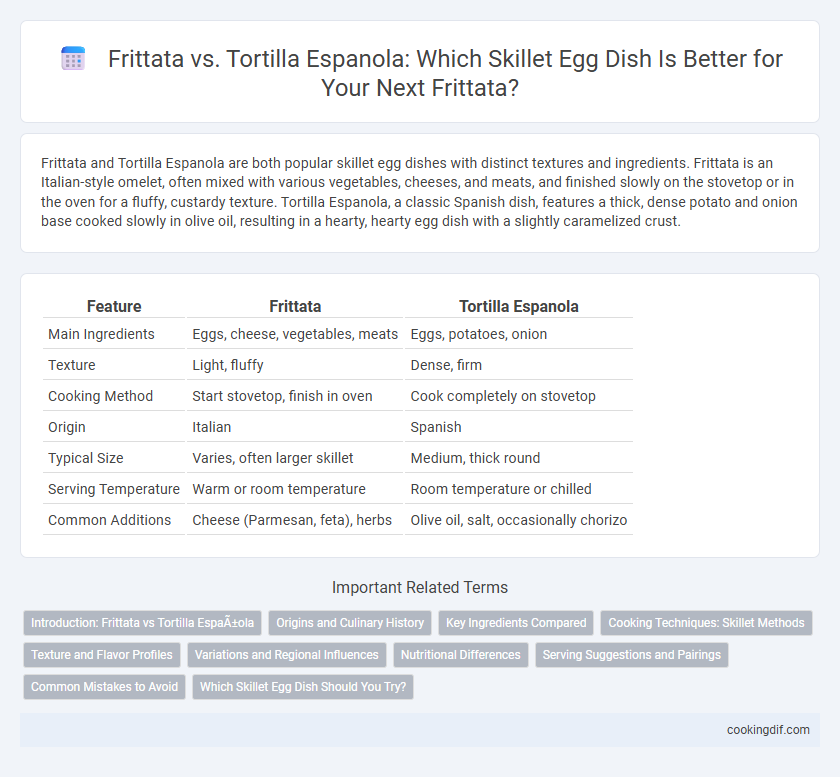Frittata and Tortilla Espanola are both popular skillet egg dishes with distinct textures and ingredients. Frittata is an Italian-style omelet, often mixed with various vegetables, cheeses, and meats, and finished slowly on the stovetop or in the oven for a fluffy, custardy texture. Tortilla Espanola, a classic Spanish dish, features a thick, dense potato and onion base cooked slowly in olive oil, resulting in a hearty, hearty egg dish with a slightly caramelized crust.
Table of Comparison
| Feature | Frittata | Tortilla Espanola |
|---|---|---|
| Main Ingredients | Eggs, cheese, vegetables, meats | Eggs, potatoes, onion |
| Texture | Light, fluffy | Dense, firm |
| Cooking Method | Start stovetop, finish in oven | Cook completely on stovetop |
| Origin | Italian | Spanish |
| Typical Size | Varies, often larger skillet | Medium, thick round |
| Serving Temperature | Warm or room temperature | Room temperature or chilled |
| Common Additions | Cheese (Parmesan, feta), herbs | Olive oil, salt, occasionally chorizo |
Introduction: Frittata vs Tortilla Española
Frittata and Tortilla Espanola are two popular skillet egg dishes with distinct origins and preparation methods. The frittata, originating from Italy, is an open-faced omelet enriched with various vegetables, cheeses, and meats, cooked slowly on the stovetop and finished in the oven. In contrast, the Spanish Tortilla Espanola combines eggs with thinly sliced potatoes and onions, cooked gently to create a thick, hearty, and dense egg dish traditional to Spain.
Origins and Culinary History
Frittata, originating from Italy, is a versatile egg-based dish often cooked slowly in a skillet and finished under a broiler, highlighting its Mediterranean roots dating back to the 16th century. Tortilla Espanola, or Spanish omelette, stems from Spain in the 18th century and traditionally includes potatoes and onions, reflecting its background as a humble peasant dish. Both showcase regional ingredients and cooking methods but differ in texture and layering, rooted in their distinct cultural histories.
Key Ingredients Compared
Frittata features beaten eggs combined with ingredients like cheese, vegetables, and cured meats, cooked slowly to create a fluffy, crustless dish, whereas Tortilla Espanola primarily consists of eggs, thinly sliced potatoes, and onions cooked in olive oil, resulting in a denser, heartier texture. The frittata's inclusion of dairy products and diverse fillings offers a richer flavor profile, contrasting with the simplicity and earthy notes of the tortilla's potato base. Both dishes utilize eggs as the protein source but differ significantly in ingredient composition and culinary technique, influencing taste and texture.
Cooking Techniques: Skillet Methods
Frittata cooking involves slow, gentle heat on the stovetop followed by finishing under a broiler or in the oven to set the eggs evenly without scrambling. Tortilla Espanola requires cooking thin potato slices in oil until tender, layering them with beaten eggs, then slow-cooking the mixture in a skillet and flipping it to achieve a thick, golden crust. Both techniques emphasize controlling heat to create a tender, cohesive egg dish, with the frittata focusing on gentle heat distribution and the tortilla Espanola on precise frying and flipping for texture.
Texture and Flavor Profiles
Frittata features a fluffy, airy texture with a rich, creamy flavor due to the incorporation of beaten eggs and dairy, often enhanced with cheese and fresh herbs. In contrast, Tortilla Espanola is denser and more cohesive, characterized by tender, slow-cooked potatoes and onions that impart a savory, slightly sweet depth. The frittata's lightness contrasts with the hearty, earthy profile of the tortilla, making each ideal for distinct skillet egg experiences.
Variations and Regional Influences
Frittata and Tortilla Espanola differ in variations and regional influences, with frittata showcasing Italian roots through the inclusion of diverse ingredients like cheeses, vegetables, and meats, adapting to Mediterranean flavors. Tortilla Espanola, rooted in Spanish cuisine, emphasizes simplicity with primarily potatoes and onions, reflecting the rustic flavors of Spain. These regional influences shape the texture and ingredient profiles, making frittata more versatile while tortilla espanola maintains a traditional, hearty character.
Nutritional Differences
Frittata typically contains a higher protein content due to the inclusion of extra eggs and often cheese, making it richer in calcium and vitamin D compared to Tortilla Espanola. Tortilla Espanola is usually higher in carbohydrates and fiber because of the generous use of potatoes, contributing to more complex carbs and potassium. Both dishes offer essential nutrients, but the frittata leans towards protein and fats, while the tortilla provides more energy from carbohydrates and dietary fiber.
Serving Suggestions and Pairings
Frittata pairs well with fresh herbs, mixed greens, or a side of roasted vegetables, enhancing its rich, eggy texture with vibrant flavors. Tortilla Espanola is traditionally served sliced at room temperature alongside crusty bread, olives, or a simple tomato salad, emphasizing its hearty potato and onion composition. Both dishes complement light, acidic wines or sparkling water infused with citrus to balance their savory profiles.
Common Mistakes to Avoid
When preparing frittata or tortilla espanola, common mistakes include overcooking the eggs, which leads to a dry texture, and insufficient seasoning that dulls flavor complexity. Avoid stirring constantly in frittatas, as this prevents the eggs from setting properly, and do not flip the tortilla espanola too early to maintain its structural integrity. Understanding the differing cooking techniques and timing for each ensures a perfectly tender and flavorful skillet egg dish.
Which Skillet Egg Dish Should You Try?
Frittata and Tortilla Espanola are both skillet egg dishes with distinct textures and ingredients, making them unique choices. Frittata, an Italian dish, typically includes beaten eggs mixed with vegetables, cheese, and meats, cooked slowly and finished under a broiler for a fluffy, custard-like consistency. Tortilla Espanola, a Spanish classic, combines sliced potatoes and onions with eggs, creating a dense, hearty omelet that is cooked slowly on the stovetop and flipped to brown both sides evenly.
Frittata vs Tortilla Española for skillet eggs Infographic

 cookingdif.com
cookingdif.com